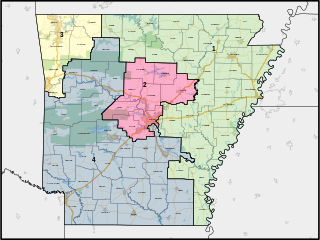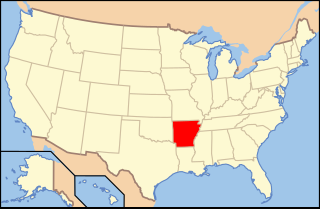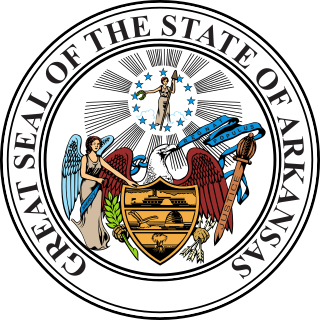Related Research Articles

Arkansas is a landlocked state in the West South Central region of the Southern United States. It borders Missouri to the north, Tennessee and Mississippi to the east, Louisiana to the south, Texas to the southwest, and Oklahoma to the west. Its name derives from the Osage language, and refers to their relatives, the Quapaw people. The state's diverse geography ranges from the mountainous regions of the Ozark and Ouachita Mountains, which make up the U.S. Interior Highlands, to the densely forested land in the south known as the Arkansas Timberlands, to the eastern lowlands along the Mississippi River and the Arkansas Delta.

William Savin Fulton was an American lawyer and politician who served as a United States Senator from Arkansas from 1836 until his death in 1844. He had previously served as the fourth governor of Arkansas Territory, from 1835 to 1836, and the second secretary of the Arkansas Territory from 1829 to 1835.

Henry Wharton Conway was a United States naval officer during the War of 1812 and a politician in Arkansas Territory, who was elected as a territorial delegate (1823–1827) to the United States House of Representatives for three consecutive congresses. He died in 1827 as a result of wounds from a duel with Robert Crittenden, a former friend and political ally.

Ambrose Hundley Sevier was an attorney, politician and planter from Arkansas. A member of the political Conway-Johnson family that dominated the state and national delegations in the antebellum years, he was elected by the legislature as a Democratic U.S. Senator. He served as Speaker of the Arkansas House of Representatives.

Robert Ward Johnson was an American planter and lawyer who served as the senior Confederate States senator for Arkansas, a seat that he was elected to in 1861. He previously served as a delegate from Arkansas to the Provisional Congress of the Confederate States from 1861 to 1862.

The Arkansas Territory was a territory of the United States from July 4, 1819, to June 15, 1836, when the final extent of Arkansas Territory was admitted to the Union as the State of Arkansas. Arkansas Post was the first territorial capital (1819–1821) and Little Rock was the second (1821–1836).
Since Arkansas became a U.S. state in 1836, it has sent congressional delegations to the United States Senate and United States House of Representatives, beginning with the 25th United States Congress in 1837. Before becoming a state, the Arkansas Territory elected a non-voting delegate at-large to Congress, beginning with the 16th United States Congress in 1819. Each state elects two senators to serve for six years in general elections, with their re-election staggered. Prior to the ratification of the Seventeenth Amendment in 1913, senators were elected by the Arkansas General Assembly. Each state elects varying numbers of members of the House, depending on population, to two-year terms.
The 1836–37 United States House of Representatives elections were held on various dates in various states between July 4, 1836, and November 7, 1837. Each state set its own date for its elections to the House of Representatives, either before or after the first session of the 25th United States Congress convened on September 4, 1837. With Arkansas and Michigan officially achieving statehood in 1836 and 1837, respectively, the size of the House was set at 242 seats.

The U.S. state of Arkansas currently has four United States congressional districts. The state has had as many as seven districts; the 5th district existed from 1883 through 1963. The 6th existed from 1893 to 1963. The 7th existed from 1903 to 1953. No Democrat has won a House seat in the state since 2012.
Conway-Johnson family was a prominent American political family from Arkansas of British origin. It was founded by Henry Wharton Conway of Greene County, Tennessee, who had come to the state of Arkansas in 1820 with his younger brother James and his cousins Elias and Wharton Rector, all of whom were deputy-surveyors under the patronage of their uncle, William Rector, Surveyor General of Missouri, Illinois, and Arkansas.

The following is an alphabetical list of articles related to the U.S. State of Arkansas.

The secretary of state of Arkansas is one of the elected constitutional officers of the U.S. state of Arkansas.

The following outline is provided as an overview of and topical guide to the U.S. state of Arkansas:

The General Assembly of Arkansas is the state legislature of the U.S. state of Arkansas. The legislature is a bicameral body composed of the upper house Arkansas Senate with 35 members, and the lower Arkansas House of Representatives with 100 members. All 135 representatives and state senators represent an equal number of constituent districts.

The 1836–37 United States Senate elections were held on various dates in various states. As these U.S. Senate elections were prior to the ratification of the Seventeenth Amendment in 1913, senators were chosen by state legislatures. Senators were elected over a wide range of time throughout 1836 and 1837, and a seat may have been filled months late or remained vacant due to legislative deadlock. In these elections, terms were up for the senators in Class 3.

The 1836 United States presidential election in Arkansas took place between November 3 and December 7, 1836, as part of the 1836 United States presidential election. Voters chose three representatives, or electors to the Electoral College, who voted for President and Vice President.
References
- ↑ "Today in History: June 15". loc.gov. Library of Congress.